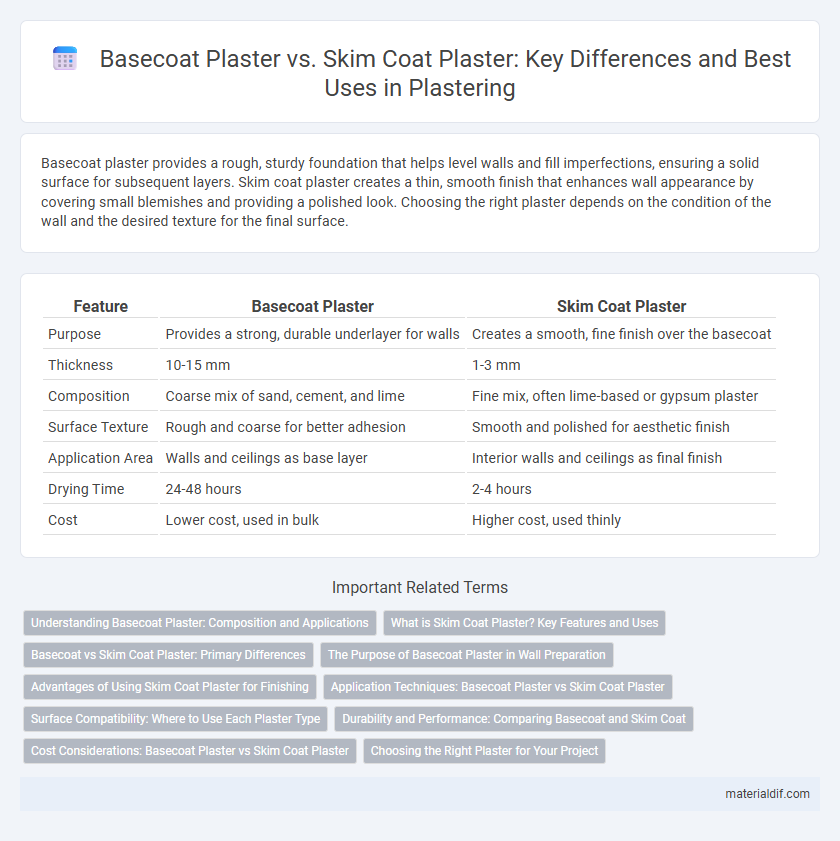Basecoat plaster provides a rough, sturdy foundation that helps level walls and fill imperfections, ensuring a solid surface for subsequent layers. Skim coat plaster creates a thin, smooth finish that enhances wall appearance by covering small blemishes and providing a polished look. Choosing the right plaster depends on the condition of the wall and the desired texture for the final surface.
Table of Comparison
| Feature | Basecoat Plaster | Skim Coat Plaster |
|---|---|---|
| Purpose | Provides a strong, durable underlayer for walls | Creates a smooth, fine finish over the basecoat |
| Thickness | 10-15 mm | 1-3 mm |
| Composition | Coarse mix of sand, cement, and lime | Fine mix, often lime-based or gypsum plaster |
| Surface Texture | Rough and coarse for better adhesion | Smooth and polished for aesthetic finish |
| Application Area | Walls and ceilings as base layer | Interior walls and ceilings as final finish |
| Drying Time | 24-48 hours | 2-4 hours |
| Cost | Lower cost, used in bulk | Higher cost, used thinly |
Understanding Basecoat Plaster: Composition and Applications
Basecoat plaster typically consists of a mixture of sand, cement, and lime, designed to provide a strong, durable layering on walls and ceilings as the initial plastering application. It serves as a foundational surface that can withstand structural stresses and helps to even out wall imperfections before applying a finer finish coat. Commonly used in both interior and exterior settings, basecoat plaster enhances adhesion and ensures long-lasting stability for subsequent layers like skim coat plaster.
What is Skim Coat Plaster? Key Features and Uses
Skim coat plaster is a thin, smooth layer of finishing plaster applied over basecoat plaster to create a polished surface ready for painting or wallpapering. Key features include its fine texture, ability to fill minor wall imperfections, and quick drying time, making it ideal for enhancing wall appearance. Commonly used in interior walls and ceilings, skim coat plaster improves surface uniformity and durability for a high-quality finish.
Basecoat vs Skim Coat Plaster: Primary Differences
Basecoat plaster provides a rough, sturdy substrate applied first to walls or ceilings, enhancing adhesion and surface leveling, while skim coat plaster offers a thin, smooth finish layer to achieve a polished appearance. Basecoat typically contains coarser aggregates for durability and thickness, whereas skim coat consists of fine, lightweight materials for a sleek texture. The primary difference lies in function: basecoat builds structural integrity, and skim coat refines aesthetics.
The Purpose of Basecoat Plaster in Wall Preparation
Basecoat plaster serves as the foundational layer in wall preparation, providing a durable and even surface that enhances adhesion for subsequent finishes. It helps to level uneven wall surfaces, fill minor imperfections, and improve the structural integrity of the plaster system. Proper application of basecoat plaster ensures a solid base for skim coat plaster, which delivers a smooth final finish.
Advantages of Using Skim Coat Plaster for Finishing
Skim coat plaster provides a smooth and flawless surface ideal for final finishing, enhancing paint adhesion and durability. Its thin application minimizes material usage and drying time compared to basecoat plaster. Skim coat plaster effectively covers minor imperfections, resulting in a polished, high-quality wall finish.
Application Techniques: Basecoat Plaster vs Skim Coat Plaster
Basecoat plaster requires a rough, thick application to create a strong, durable surface that adheres well to masonry or drywall substrates, often applied in multiple layers and allowed to cure before additional finishes. Skim coat plaster involves a thin, smooth layer typically spread with a trowel to create a flawless, even surface ideal for painting or wallpaper, emphasizing precision and minimal thickness. The application technique for basecoat prioritizes structural bonding and texture, while skim coat focuses on surface refinement and aesthetic smoothness.
Surface Compatibility: Where to Use Each Plaster Type
Basecoat plaster is ideal for rough, uneven surfaces such as masonry, concrete, or block walls, providing a strong, durable foundation for further finishing. Skim coat plaster is best suited for smooth, already plastered walls or drywall, enhancing surface smoothness and preparing ceilings or walls for painting and wallpaper. Applying the appropriate plaster type ensures optimal adhesion and long-term surface integrity.
Durability and Performance: Comparing Basecoat and Skim Coat
Basecoat plaster offers enhanced durability due to its thicker application, making it ideal for leveling uneven surfaces and providing a strong foundation for subsequent layers. Skim coat plaster, being thinner and smoother, excels in performance for finishing touches by creating a flawless surface but lacks the robustness of basecoat plaster against cracks and impact. Choosing between basecoat and skim coat plaster depends on whether structural strength or aesthetic smoothness is prioritized in the plastering project.
Cost Considerations: Basecoat Plaster vs Skim Coat Plaster
Basecoat plaster is generally more cost-effective than skim coat plaster due to its thicker application and use as a foundational layer, reducing material and labor expenses. Skim coat plaster requires a finer finish and more skill, leading to higher costs in both materials and workmanship. Evaluating project budgets, basecoat plaster suits structural needs, while skim coat plaster is ideal for enhancing surface smoothness and appearance despite the increased investment.
Choosing the Right Plaster for Your Project
Basecoat plaster provides a sturdy and thick layer ideal for creating a strong foundation on rough walls, while skim coat plaster offers a smooth, thin finish perfect for preparing surfaces for painting or wallpaper. Choosing the right plaster depends on the condition of your walls and the desired final texture, with basecoat enhancing durability and skim coat improving aesthetic appeal. Assess wall irregularities and project goals to determine whether the robust base layer or the fine finishing coat best fits your construction or renovation needs.
Basecoat plaster vs Skim coat plaster Infographic

 materialdif.com
materialdif.com